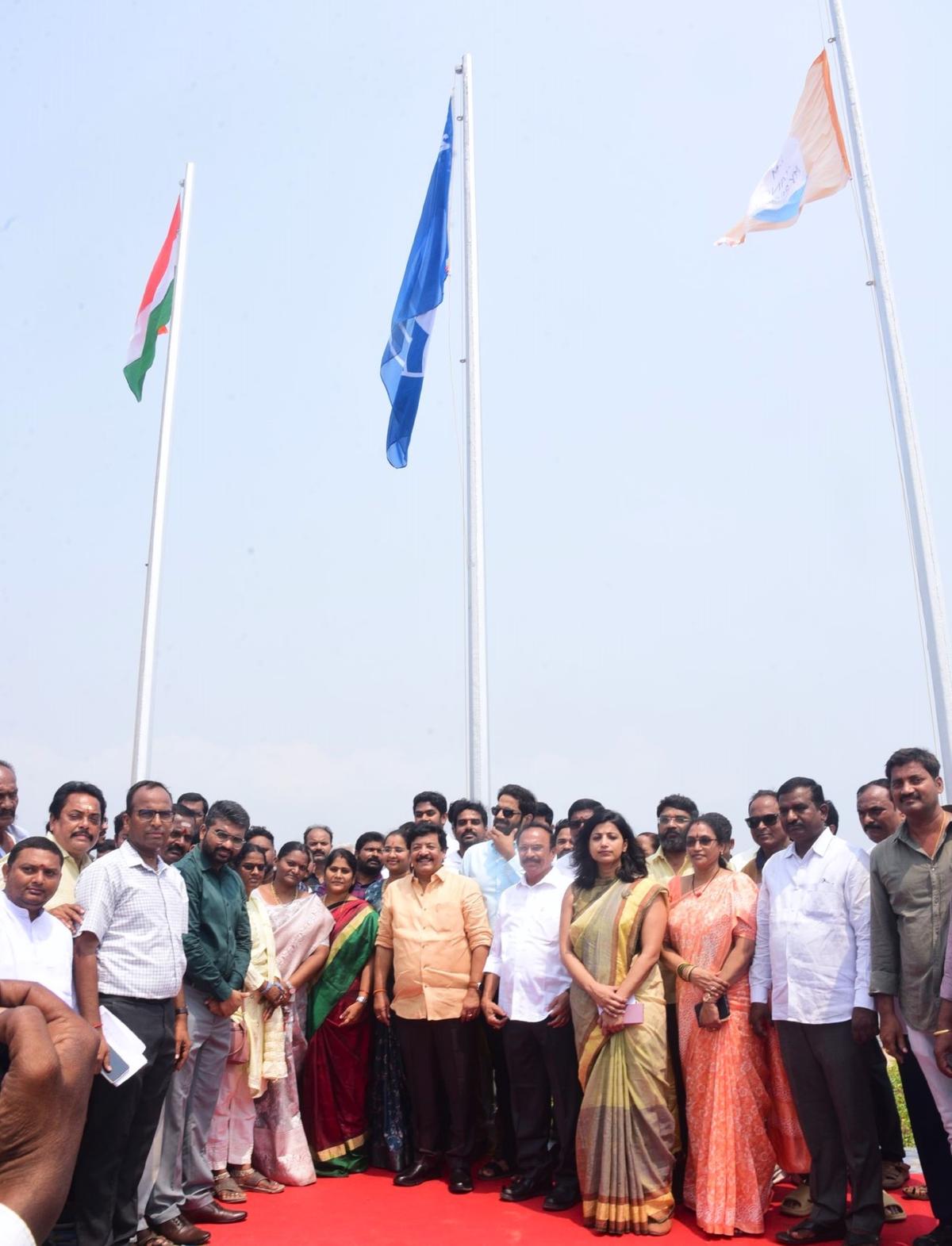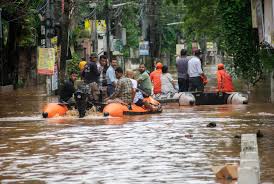Rushikonda Beach Regains prestigious Blue Flag Certification

- 27 Mar 2025
In News:
Rushikonda Beach, located in Visakhapatnam, Andhra Pradesh, has successfully regained its Blue Flag certification after a temporary withdrawal due to non-compliance issues. It remains the only Blue Flag-certified beach in Andhra Pradesh and one of 13 such beaches in India.
What is the Blue Flag Certification?
- Administered by: Foundation for Environmental Education (FEE), Denmark.
- National Operator in India: Blue Flag India under the Society of Integrated Coastal Management (SICOM).
- Purpose: Recognizes beaches meeting strict standards of environmental management, safety, cleanliness, and facilities.
- Criteria: Beaches must comply with 33 environmental and safety criteria, including water quality, waste management, safety measures, and environmental education.
- Control Visits: National Operator conducts scheduled and surprise inspections.
Reasons for Temporary Withdrawal
- The Blue Flag tag was withdrawn after complaints of poor maintenance and non-compliance with amenities.
- Non-compliance types:
- Minor issues require rectification within 10 days.
- Multiple or major issues can lead to temporary or season-long withdrawal.
- Rushikonda Beach lost the tag for about two weeks before corrective measures were implemented.
Measures Taken for Regaining the Blue Flag
- Repair and upgrade of beach amenities.
- Plans to install bamboo fencing around the premises to protect the area.
- Public appeals to avoid littering and misuse.
- Education drives for local fisherfolk on beach cleanliness.
- Plans to promote tourism with new beach shacks and regulated alcohol sales, awaiting government approval.
- Identification of 10 other beaches in Andhra Pradesh for upgradation and Blue Flag certification.
Importance of the Blue Flag Tag for Rushikonda Beach
- Tourism Impact: The Blue Flag is internationally recognized by tourists as a mark of safety, cleanliness, and eco-friendliness.
- Environmental Awareness: Promotes responsible tourism and protects coastal ecosystems.
- Local Economy: Supports livelihoods of petty vendors and fisherfolk by attracting visitors.
Key Facts About Rushikonda Beach
- Location: Visakhapatnam, Andhra Pradesh.
- Awarded Blue Flag: First awarded in 2020.
- Features: Golden sands, clear waters, and well-maintained recreational amenities.
- Significance: The only Blue Flag beach in Andhra Pradesh and among 13 in India.
India’s First Frozen Zoo

- 27 Mar 2025
In News:
In a pioneering conservation step, Padmaja Naidu Himalayan Zoological Park (PNHZP) in Darjeeling, West Bengal, has become India’s first zoo to launch a DNA cryogenic conservation project—popularly known as a “frozen zoo”.
About the DNA Cryogenic Conservation Initiative
- Objective: Preserve genetic material of endangered Himalayan species for future research, assisted reproduction, and biodiversity conservation in case of extinction threats.
- Launched in:2023, with 60 DNA samples already collected.
- Collaborators:
- PNHZP, Darjeeling
- Centre for Cellular and Molecular Biology (CCMB), Hyderabad
- Species covered: Red pandas, snow leopards, Himalayan black bears, and other native animals.
- Source of Samples: Tissue collected from animals deceased in captivity or road accidents.
- Storage Method:
- DNA samples stored in liquid nitrogen at –196°C.
- A dedicated in-zoo laboratory with steel cryo-containers established.
About the Centre for Cellular and Molecular Biology (CCMB)
- Established: 1977; full national lab status in 1981–82.
- Location: Hyderabad, Telangana.
- Affiliation: Under Council of Scientific and Industrial Research (CSIR).
- Recognition: Designated a “Center of Excellence” by UNESCO’s Global Molecular and Cell Biology Network.
- Mandate: Advanced research and training in frontier areas of modern biology.
About Padmaja Naidu Himalayan Zoological Park
Feature Description
Location Darjeeling, West Bengal
Altitude 2,150 metres (7,050 feet) – India’s highest-altitude zoo
Area 67.8 acres
Established 14 August 1958
Renamed 1975 in memory of Padmaja Naidu, former Governor of West Bengal
Transferred to State 1993; now under Ministry of Environment, Forest and Climate Change (MoEFCC)
Focus Areas Ex-situ conservation, education, research, and captive breeding
Notable Species Red pandas, snow leopards, Himalayan wolves, gorals, Siberian tigers
India’s First Indigenous MRI Scanner Installed at AIIMS
- 27 Mar 2025
In News:
AIIMS New Delhi is set to install India’s first indigenously developed MRI scanner for clinical evaluation by October 2025. This marks a major milestone under the government's push for import substitution and promotion of ‘Make in India’ in the medical device sector.
Key Highlights:
- MRI Type: 1.5 Tesla Magnetic Resonance Imaging (MRI) system.
- Developed by: SAMEER (Society for Applied Microwave Electronics Engineering and Research), an autonomous R&D institution under the Ministry of Electronics and Information Technology (MeitY).
- Initiative under: National Mission SCAN-ERA (Swadeshi Chumbakiya Anu-naadChitran – EkRashtriyaAbhiyaan), launched in December 2014.
- Purpose: Clinical evaluation and performance feedback at AIIMS to refine the system for wide-scale clinical use.
- Objective: Reduce dependence on imported diagnostic equipment and lower treatment costs.
Significance:
- Currently, 80–85% of India's medical devices are imported.
- In FY 2023–24, India’s medical device import bill rose by 13% to ?69,000 crore.
- The initiative aligns with the Production-Linked Incentive (PLI) Scheme for medical devices, under which 7 critical devices (including MRI machines, CT scanners, LINACs, heart valves, etc.) are now being domestically manufactured.
- 19 PLI-supported projects have been commissioned to manufacture 46 medical devices.
MRI: How It Works
- Principle: Uses strong magnetic fields and radiofrequency pulses to align protons in tissues. As protons return to their original alignment, they emit signals that are captured to create detailed 3D anatomical images.
- Applications:
- Imaging soft tissues, brain, spinal cord, joints, and internal organs.
- Detecting tumors, strokes, neurological disorders, and musculoskeletal injuries.
- Functional MRI (fMRI) maps brain activity during cognitive tasks.
Safety & Limitations:
- Magnetic interference: Risky for patients with implants (e.g., pacemakers).
- Noise: Loud clicking sounds may cause discomfort.
- Claustrophobia: May cause anxiety in closed spaces; open MRI designs mitigate this.
- Contrast agents: Use of gadolinium-based agents can pose risks to dialysis patients.
Disaster Management (Amendment) Bill, 2024

- 27 Mar 2025
In News:
The Parliament has passed the Disaster Management (Amendment) Bill, 2024, aiming to strengthen disaster response mechanisms.
Ministry: Home Affairs
Background
The Disaster Management Act, 2005 established a three-tier structure:
- National Disaster Management Authority (NDMA)
- State Disaster Management Authorities (SDMAs)
- District Disaster Management Authorities (DDMAs)
These bodies were responsible for disaster planning, mitigation, and response at national, state, and district levels respectively.
Key Amendments
1. Preparation of Disaster Management Plans
- Earlier: Executive Committees were responsible for preparing disaster plans.
- Now: NDMA and SDMA will directly prepare and approve national and state disaster management plans.
2. Expanded Functions of NDMA and SDMA
New responsibilities include:
- Periodic risk assessments, including risks from climate-related events.
- Technical guidance to lower-level authorities.
- Minimum standards of relief recommendations.
- Creation of disaster databases containing:
- Disaster risk profiles
- Fund allocations and expenditures
- Preparedness and mitigation strategies
- NDMA-specific roles:
- Assessment of state preparedness
- Post-disaster audits to evaluate response effectiveness
3. Urban Disaster Management Authorities (UDMAs)
- To be established in state capitals and municipal corporation areas.
- Composition:
- Chairperson: Municipal Commissioner
- Vice Chairperson: District Collector
- Additional members as per state government notification
- Responsible for urban disaster planning and implementation.
4. State Disaster Response Force (SDRF)
- States are empowered to establish SDRFs for specialized disaster response.
- Functions and service conditions to be defined by state governments.
5. Statutory Status to Key Committees
- National Crisis Management Committee (NCMC):
- Nodal body for major national disasters
- Chaired by the Cabinet Secretary
- High-Level Committee (HLC):
- Sanctions financial assistance to states
- Chaired by the concerned Union Minister
6. NDMA Staffing and Appointments
- NDMA can determine the number and type of officers and staff.
- Can appoint experts and consultants with prior central government approval.
Rationale Behind the Amendment
- Climate Change: Increased frequency of extreme weather events necessitates proactive strategies.
- Decentralization Gaps: States faced implementation challenges under the 2005 Act.
- Institutional Strengthening: Clearer roles for national and sub-national bodies.
- Technology and Data Integration: Emphasis on real-time data and performance audits.
Key Concerns and Criticism
- Centralization of Power:NDMA’s enhanced role may reduce state autonomy in disaster response.
- Overlap with State Authority:Potential encroachment on state disaster planning and fund utilization.
- Delayed Relief via NDRF:Increased central oversight may slow localized relief efforts.
- Omission of Emerging Threats:Excludes disasters like heatwaves from official definitions.
- Lack of State-Specific Relief Funds:Demand for region-focused financial provisions by states like Bihar.
Way Forward
- Ensure Federal Balance: Maintain cooperation between Centre and states.
- Update Definitions: Include climate-induced disasters like heatwaves.
- Transparent Funding Mechanism: Clear protocols for fund allocation and usage.
- Empower Local Bodies: Strengthen DDMAs and UDMAs through training and resources.
- Institutional Audits: Regular post-disaster audits to enhance future readiness.
FAO’s 3rd Report on the State of the World’s Plant Genetic Resources for Food and Agriculture (2025)
- 27 Mar 2025
In News:
The diversity of plant genetic resources for food and agriculture was under growing threat as despite 6,000 plant species cultivated, 60 per cent of the global crop production was alarmingly dependent on just nine crops, an important report by the United Nations Food and Agriculture Organization (FAO).
Key Highlights:
- Released by:Food and Agriculture Organization (FAO), under the Commission on Genetic Resources for Food and Agriculture (CGRFA-20).
- Crop Dependency & Diversity:
- 60% of global crop production is dependent on just 9 crops:Sugarcane, Maize, Rice, Wheat, Potatoes, Soybeans, Oil Palm Fruit, Sugar Beet, Cassava.
- Though 6,000 plant species are cultivated globally, there is a rising loss of genetic diversity, increasing vulnerability to climate shocks and food insecurity.
- Farmers’ Varieties / Landraces (FV/LRs):
- Traditional crop varieties adapted to local conditions, offering greater resilience to climate, pests, and diseases.
- Globally, 6% of FV/LRs are threatened; this figure exceeds 18% in some regions like Southern Africa, the Caribbean, and Western Asia.
- In India, over 50% of FV/LRs across five agro-ecological zones are at risk of extinction.
- Conservation Efforts
- In-situ (on-farm): Around 35 million hectares in 51 countries are under cultivation with FV/LRs.
- 42% of plant taxa are threatened at species or varietal level.
- Ex-situ (off-farm):
- Over 5.9 million accessions preserved globally.
- Many stored in the Svalbard Global Seed Vault.
- Conservation is constrained by funding, political support, infrastructure, and skilled personnel shortages.
- In-situ (on-farm): Around 35 million hectares in 51 countries are under cultivation with FV/LRs.
India-Specific Initiative
- Seed Hub Initiative (2016) by the Ministry of Agriculture:
- Aimed at promoting high-yielding varieties (HYVs) of pulses.
- Resulted in increased production from 14.76 million tonnes (2007–08) to 24.42 million tonnes (2020–21).
Impact of Climate Change
- Increasing frequency of extreme weather events threatens crop diversity.
- Countries lack mechanisms to assess disaster impacts on crop genetics.
- Post-disaster germplasm distribution often suffers due to poor seed adaptation to local agro-climatic and cultural contexts.
Key Challenges
- Genetic erosion due to monoculture, urbanization, and climate stress.
- Underfunded gene banks and weak institutional capacity.
- Lack of trained plant genetic experts and documentation gaps.
- Limited access to locally adapted seeds, especially post-disaster.
Way Forward
- Integrate in-situ and ex-situ conservation with community participation.
- Enhance funding and explore public-private partnerships.
- Build capacity in taxonomy, plant breeding, and genebank management.
- Promote participatory breeding with farmers and Indigenous communities.
- Strengthen policy support for crop diversification and climate-resilient agriculture.
About CGRFA
- Established: 1983 by FAO.
- Mandate: Only intergovernmental body focusing on sustainable use of agricultural biodiversity.
- Membership: 179 countries + European Union.
- Major Achievement:Instrumental in adoption of International Treaty on Plant Genetic Resources for Food and Agriculture (ITPGRFA), 2001.
